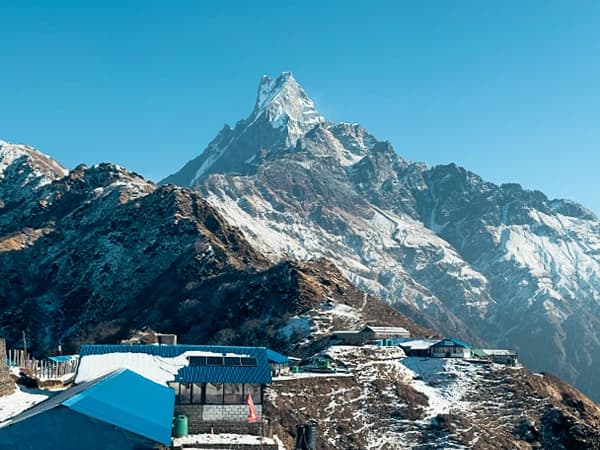When should one go on the Ghorepani Poon Hill walk?
Trekking Ghorepani Poon Hill ideal periods are March through May and October through November. These days show beautiful skies, mild temperatures, and breathtaking views.
Still, the path is open all year; spring delivers rich rhododendron woodlands and autumn presents amazing Himalayan settings.
Monsoon season (June to September) provides muddy tracks while winter, December to February, sees snow and cold temperatures, making some paths unusable.
For optimal experience, schedule your climb for the dry seasons. Remember, though, every season has particular charm and Ghorepani Poon Hill is climbable all year long.
How difficult is the Ghorepani Poon Hill trek for beginners?
Families and beginners would find the Ghorepani Poon Hill walk ideal as it is so conveniently located. All ages can enjoy the wonderful scenery and cultural richness along the little walks and reasonable hills.
Before beginning, find everyone's level of preparation. Every competitor should have appropriate shoes, clothing, and trekking gear. Be hydrated, take breaks, and notice signals your body gives for a safe journey.
While the climb is appropriate for beginners, having a professional guide enhances the journey. Our informed guide will be here to ensure your safety and provide understanding of the local way of life.
Families and beginners have a great opportunity to interact among the Himalayan magnificence with the Ghorepani Poon Hill hike. Thus, lacing your boots will help you to be ready for a wonderful excursion by combining your preferred ones!
What should I bring for the climb on Ghorepani Poon Hill?
Good and fun trekking on the Ghorepani Poon Hill path depends on carrying the appropriate tools and equipment. This is a general packing guide:
Clothing:
Layering is what helps one adapt to changing weather. Lay insulating mid-layers, waterproof and windproof outer shells, base layers with moisture-wicking ability. Don't undervalue including a fleece or thick down jacket for early mornings and chilly evenings.
Footwear:
For negotiating different terrain, invest in a strong pair of hiking boots with ankle support and high traction. Before the walk to avoid blisters and pain, break them in.
Accessories:
To cover against the sun and dust, pack a lightweight scarf or buff, sunglasses with UV protection, and a broad-brimmed cap or hat. For more warmth at higher altitudes, think about including a beanie and gloves.
Backpack:
To equally distribute the weight, get a well-fitting, comfortable backpack with hip belt and padded straps. Choose a size that will fit your needs including extra clothing, photography equipment, water, and snacks.
Sleeping Bag:
Although teahouses offer bedding, it's best to pack a lightweight sleeping bag for extra warmth and comfort—especially on colder evenings at higher altitudes.
Hydration and Nutrition:
Carry a reusable water bottle or hydration bladder to stay hydrated; treat water from natural sources using filtration system or purifying pills. To power your trekking exploits, pack energy-dense snacks include dried fruits, granola bars, and trail mix.
Personal Care:
Don't forget to carry sunscreen with a high SPF, lip balm with UV protection, insect repellent, personal hygiene basics including wet wipes, hand sanitizer, and biodegradable toiletries. Add a basic first aid box including painkillers, adhesive bandages, blister patches, and altitude sickness medicine.
Trekking Poles:
Particularly for steep ascents and descents, think about packing trekking poles for extra stability and support. Trekking is more pleasant if you use adjustable poles with ergonomic grips since they help to ease tension on your muscles and joints.
Note: During the journey, we at Shikhar Adventure supply you sleeping bags, trekking sticks and duffel bags; they must be returned upon the end of the trip.
Thoughtful packing and prioritizing basics will help you to be ready to meet the obstacles of the Ghorepani Poon Hill walk while keeping comfortable, safe, and totally submerged in the breathtaking splendor of the Himalayas.
Can I do the trek independently, or is a guide necessary?
Although the Ghorepani Poon Hill walk could be done alone, hiring a local guide has various benefits and is strongly encouraged, especially for first-time walkers and those not familiar with the area.
Local guides guarantee safety all along the journey by their great awareness of the terrain, weather patterns, and cultural peculiarities, therefore enhancing the complete trekking experience. They can readily negotiate the routes, offer insights on the natural flora and animals; they also provide cultural interpretation, which encourages you to value the scene and communities you come across.
Guides can also assist with logistical preparations like license acquisition, housing, and vehicle arrangement so saving you time and effort. Should unexpected occurrences or crises strike, such altitude illness or terrible weather, guides are advised to respond quickly and forcefully, giving your health first importance.
Hiring a guide also benefits the surrounding companies and promotes environmentally friendly travel, therefore supporting the remote Himalayan villages. Although free and flexible individual trekking offers, the knowledge and company of a certified guide will improve your trip and create lifetime experiences in the highlands.













